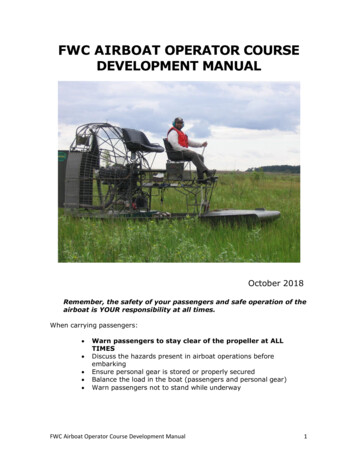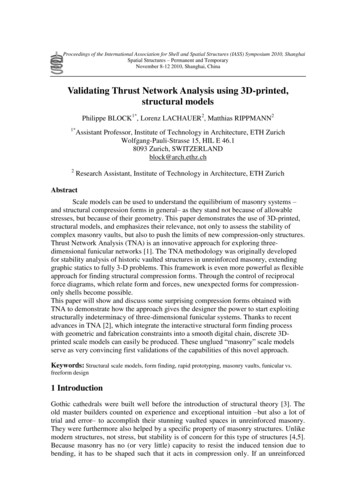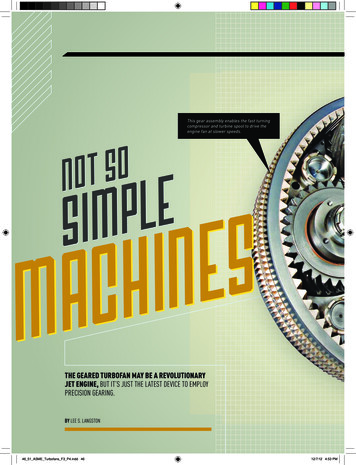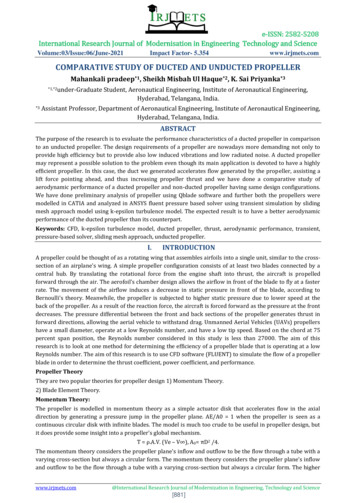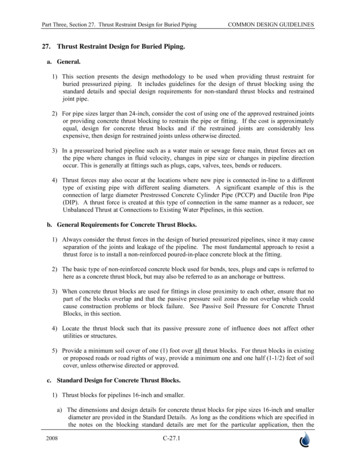
Transcription
Part Three, Section 27. Thrust Restraint Design for Buried PipingCOMMON DESIGN GUIDELINES27. Thrust Restraint Design for Buried Piping.a. General.1) This section presents the design methodology to be used when providing thrust restraint forburied pressurized piping. It includes guidelines for the design of thrust blocking using thestandard details and special design requirements for non-standard thrust blocks and restrainedjoint pipe.2) For pipe sizes larger than 24-inch, consider the cost of using one of the approved restrained jointsor providing concrete thrust blocking to restrain the pipe or fitting. If the cost is approximatelyequal, design for concrete thrust blocks and if the restrained joints are considerably lessexpensive, then design for restrained joints unless otherwise directed.3) In a pressurized buried pipeline such as a water main or sewage force main, thrust forces act onthe pipe where changes in fluid velocity, changes in pipe size or changes in pipeline directionoccur. This is generally at fittings such as plugs, caps, valves, tees, bends or reducers.4) Thrust forces may also occur at the locations where new pipe is connected in-line to a differenttype of existing pipe with different sealing diameters. A significant example of this is theconnection of large diameter Prestressed Concrete Cylinder Pipe (PCCP) and Ductile Iron Pipe(DIP). A thrust force is created at this type of connection in the same manner as a reducer, seeUnbalanced Thrust at Connections to Existing Water Pipelines, in this section.b. General Requirements for Concrete Thrust Blocks.1) Always consider the thrust forces in the design of buried pressurized pipelines, since it may causeseparation of the joints and leakage of the pipeline. The most fundamental approach to resist athrust force is to install a non-reinforced poured-in-place concrete block at the fitting.2) The basic type of non-reinforced concrete block used for bends, tees, plugs and caps is referred tohere as a concrete thrust block, but may also be referred to as an anchorage or buttress.3) When concrete thrust blocks are used for fittings in close proximity to each other, ensure that nopart of the blocks overlap and that the passive pressure soil zones do not overlap which couldcause construction problems or block failure. See Passive Soil Pressure for Concrete ThrustBlocks, in this section.4) Locate the thrust block such that its passive pressure zone of influence does not affect otherutilities or structures.5) Provide a minimum soil cover of one (1) foot over all thrust blocks. For thrust blocks in existingor proposed roads or road rights of way, provide a minimum one and one half (1-1/2) feet of soilcover, unless otherwise directed or approved.c. Standard Design for Concrete Thrust Blocks.1) Thrust blocks for pipelines 16-inch and smaller.a) The dimensions and design details for concrete thrust blocks for pipe sizes 16-inch and smallerdiameter are provided in the Standard Details. As long as the conditions which are specified inthe notes on the blocking standard details are met for the particular application, then the2008C-27.1
Part Three, Section 27. Thrust Restraint Design for Buried PipingCOMMON DESIGN GUIDELINESstandard detail applies and can be simply referenced on the contract drawings. If any of theconditions on the standard detail cannot be met, then special design blocking is required asindicated below. Also, see Part Three, Section 6, Modifications to Specifications and StandardDetails.b) If the design pressure for the project is significantly less than the design pressure used for thestandard detail blocking, such as for low pressure treatment plant process piping, sewage forcemains, etc., then evaluate the economics of downsizing the standard detail blockingaccordingly, depending on the number of blocks required, design costs, etc. If the designrequires the standard details to be modified, see the requirements for Special Design ConcreteThrust Blocks indicated below.2) Soil investigation requirements for the use of standard design blocking.a) A soil boring is generally required near the proposed thrust block location, see Part Three,Section 20, Geotechnical and Corrosion Submittals, for soil boring location requirements. Usethe information on the boring logs to confirm items b) and c) below, prior to using the blockingstandard details.b) Elevation of groundwater table must be below the bottom of the block for upper vertical bendsor the invert of the pipe for all other blocks. If the actual groundwater table is higher than theabove, then evaluate the standard block size for submerged conditions and note that a specialdesign block may be required.c) The soil at the proposed thrust block location and elevation shall not be soft with standardpenetration test blow count (N) equal to or less than four (4), nor shall the soil be organic. Ifthese conditions exist, then special design blocking is required. Other alternatives such asreplacing the in-situ soil with structural fill within the zone of influence of the thrust block orrestraining the pipe instead of using a block may also be considered.d. Special Design for Concrete Thrust Blocks.1) Pipe larger than 16-inch diameter and other cases not covered by the Standard Details. Specialdesign blocking is required according to the guidelines in this section. Submit special designcalculations, which are signed and sealed by a State of Maryland registered professional engineer,for each special design along with the drawings (plan and profile). In general, the special designdimensions can be called out on the drawings for the variable dimensions shown on the standarddetails without providing a detail of the block on the drawings. For information on changingspecifications and standard details, see Part Three, Section 6 (Modifications to Specifications andStandard Details).2) Guidelines for special design blocking are as follows:a) Soil investigation requirements for special design blocking.(1) Soil boring is required at or near the proposed location of the special design thrust block.Extend the soil boring below the invert of the pipe at least ten (10) feet, or to the estimatedbase elevation of the thrust block, whichever is greater.2008C-27.2
Part Three, Section 27. Thrust Restraint Design for Buried PipingCOMMON DESIGN GUIDELINES(2) Perform Standard Penetration Tests (SPT) at two and one half (2.5) foot intervals for theupper ten (10) feet of the boring and then every five (5) feet thereafter. If cohesive soils areencountered, obtain undisturbed samples near the springline of the pipe. Perform confinedcompression strength and Atterberg limit tests on the samples.(3) The soil boring along with the laboratory tests shall provide sufficient information todetermine the following:(a) Classification of soils in accordance with the Unified Soil Classification System (ASTM D2487).(b) Field density from SPT and shear strength from unconfined compression tests or SPT.(c) Coefficients of lateral earth pressure.(d) Groundwater level, at completion and at twenty four (24) hours after the completion of theboring and removal of the augers and any casings.b) Block configuration. Thrust blocks shall generally be configured similar to those shown in thestandard details. A rectangular shaped front face shall be used for the blocks for horizontalbends, reducers, tees, plugs and caps if possible. The reasonable range of depth to width ratiofor the rectangular face shall be between 1 and 3.c) Internal design pressure.(1) Water pipelines. Compute the total internal design pressure used for blocking designaccording to Part One, Section 5 (Total Internal and Transient Pressures). Generally, thethrust restraint is designed for the total pressure. Under some special circumstances, thenecessary test pressure may be lower or higher than this total pressure. Consult WSSC as towhich pressure is to be used for the thrust restraint design.(2) Pipelines other than water pipelines. Determine the total internal design and test pressure forpipelines other than water pipelines, such as sewage force mains, treatment plant pressurepiping, etc., and use the appropriate pressure for the special design blocking.d) Design thrust force (F) for fittings.(1) When calculating thrust forces, use the outside diameter (OD) or joint sealing diameter. Thesealing diameter is the internal diameter of the gasket at the bell, where the internal waterpressure comes in contact.(2) Horizontal (HB), Upper Vertical (UVB) and Lower Vertical (LVB) Bends. Calculate thedesign thrust force or resultant force for bends.F 2 P A sin ( 2)Where:P design pressureA cross sectional area of pipe angle of the bend(3) Plugs and caps. Use the full thrust force, which is equal to the design pressure (P) times thecross sectional area (A) of the pipe. (F P A)2008C-27.3
Part Three, Section 27. Thrust Restraint Design for Buried PipingCOMMON DESIGN GUIDELINES(4) Tees, TS&V and TA&V. Use the full thrust force, which is equal to the design pressure (P)(F P A)times the cross sectional area (A) of the branch pipe.(5) Reducers. The design thrust force for reducers is equal to the design pressure (P) times thedifference of the cross sectional areas of the large (Al) and small end (As) sizes of the reducer.F P (Al As)e)Appropriate earth pressure theories to be used when designing thrust blocks.(1) Horizontal bends, reducers, tees, TS&V, TA&V, plugs and caps.(a) Design horizontal bends, reducers, tees, TS&V, TA&V, plugs and caps using one of theappropriate earth pressure theories indicated below and state the specific references used inthe design calculations.Design Method for Vertical Anchor Slabs in Sand, N. Krebs Ovesen and Helle Stromann.See pages 1481 to 1500, Performance of Earth and Earth-Supported Structures, Volume 1Part 2, ASCE, 1972.Design for Unbalanced Thrust for Buried Water Conduits, Charles A. Manganaro, seepages 705 to 716, Journal AWWA, June 1968.(b) Do not use a design concept based on bearing capacity.(c) For blocks in cohesive soils, evaluate the soil resistance in terms of short and long termshear strengths and use the lowest resistance between the two for the design.(d) Calculated net soil resistance for the block is to be at least 1.5 times the design thrust force.(2) Upper vertical bends. Design the thrust blocks for upper vertical bends such that the sum ofthe effective weight of the concrete, bend and fluid is equal to or greater than the verticalcomponent of the design thrust force.(3) Lower vertical bends. Design the thrust blocks for lower vertical bends such that the contactpressure at the bottom of the block is within the allowable soil bearing capacity.e. Design Example: Horizontal Bend Concrete Thrust Blocks.Determine size of a thrust block required for a 30"-1/8 (45 ) HB at Station 0 00.For this example, "Ovesen and Stromann" method was used.Design Parameters:Ground surface elevation at the fitting 134.4Fitting invert elevation 127.4.HHG (High Hydraulic Grade) 325 ftSurge pressure 80 lb/in2Pipe outside diameter (OD) 32.00 inches (ANSI/AWWA C150/A21.50)For obtaining HHG and surge pressure, see Part One, Section 5 (Total Internal and TransientPressures).Determine the passive soil pressure zone.A review of the plans reveals that there are no existing or proposed utilities, structures, etc.,anywhere close to the passive pressure soil zone behind the proposed thrust block, see Passive SoilPressure for Concrete Thrust Blocks, in this section.2008C-27.4
Part Three, Section 27. Thrust Restraint Design for Buried PipingCOMMON DESIGN GUIDELINESDetermine if special detail is required.Standard Detail B/1.0 for horizontal bends thrust blocks only includes up to 16-inch diameter watermains, therefore, this is a special design. Design the block using the same general blockconfiguration as the standard detail and determine the required special design dimensions. If theassumptions and limitations indicated in the "notes" on the standard detail are consistent with theparticular special design, then generally the special design dimensions can be indicated in a note onthe contract drawings referencing Standard Detail B/1.0 without providing a detail of the block onthe plans. This is true for this case, therefore the special design dimensions are determined asfollows:Determine soil design parameters.A soil boring located at the proposed fitting supports the following soil design parameters:Silty SandNo Groundwaterγ soil unit weight 120 lb/ft3φ soil friction angle 25 kλa active earth pressure coefficient 0.41Where kλa (1 - sin φ) (1 sin φ)For soil boring requirements, see Part Three, Section 20, (Geotechnical and Corrosion Submittals).Determine design pressure:P design (total) pressure ((HHG pipe invert) 0.433) surge ((325 127.4) 0.433) 80P 165.63 lb/in2Determine thrust force - Horizontal Bend:R thrust (resultant horizontal force)Where: P design (total) pressureR R 2 PA 45 (for a 1/8 HB) A 2 (165.63 lb/in2) (804.25 in2) sin (45 2)101,952.93 lbA sin ( 2)pipe cross sectional area ( π (OD)2 ) 4( 3.1415927 (32.00)2 ) 4804.25 in2Invert Elevation 127.4ELEVATIONSKETCH "II"2008C-27.5G 5 feetPLAND 11 feet (FP 3.89 feet8.7 feet (H)G 5 feetE 6 feet (h)30" W (DIP)1/8 (45 ) HBF 2 feet)Ground Surface Elevation 134.4
Part Three, Section 27. Thrust Restraint Design for Buried PipingCOMMON DESIGN GUIDELINESAssume a block size and determine the weight of the proposed block per foot width:wt weight of the concrete block/ft widthγc 150 lb/ft3 (unit weight of concrete)Using Standard Detail B/1.0, assume the following block dimensions, see Sketch "KK":F 2 feetE 6 feetD 11 feetG 5 feetFp 3.89 feetwt G E ( (Fp D ) 2 ) γc 5 ft 6 ft ( (3.89 ft 11 ft ) 2 ) 150 lb/ft3 223.35 ft3 150 lb/ft3 33,502.5 lb width 33,502.5 lb 11 ftwt 3045.68 lb/ftDetermine normal active earth pressure:Ea normal active earth pressure 1/2 γ H2 kγa 1/2 120 lb/ft3 (8.7 ft)2 0.41aE 1861.97 lb/ftDetermine tangential active earth pressure:Fa tangential active earth pressure Ea tan φ 1861.97 lb/ft tan 25Fa 868.25 lb/ftDetermine earth pressure coefficient for tangential earth pressure in front of block:kγ tan δγ earth pressure coefficient for tangential earth pressure in front of block (G Fa) (1/2 γ H2 ) (3045.68 lb/ft 868.25 lb/ft) (1/2 120 lb/ft3 (8.7 ft)2 )kγ tan δγ 0.86Determine earth pressure coefficient for normal earth pressure in front of block:kγ earth pressure coefficient for normal earth pressure in front of blockObtain from Figure "J", for ( kγ tan δγ 0.86 and φ 25 )kγ 3.25Determine anchor resistance:Ao anchor resistance (1/2 γ H2 kγ ) Ea (1/2 120 lb/ft3 (8.7 ft)2 3.25 ) 1861.97 lb/ft 14,759.55 lb/ft 1861.97 lb/ftAo 12,897.58 lb/ftDetermine effective block length:le effective block length.(le 1 / H h ) (11 1 ) ( 8.7 6 )(l e l ) ( H h ) 0.24elleel 0.24 ( H h ) lWhere:h (assumed block height)l (assumed block length)Obtain from Figure "K", for 0.68(rearrange terms to solve for le ) 6 feet 11 feetH (depth to bottom of block) 8.7 feet 0.24 (6 ft 8.7 ft) 11 ft 14.53 feetDetermine anchor resistance ratio:As / Ao anchor resistance ratioObtain from Figure "I", for (h / H 6 8.7 0.69)soA / A 0.952008C-27.6
Part Three, Section 27. Thrust Restraint Design for Buried PipingDetermine the anchor resistance or loadcapacity of block:Q anchor resistance Ao (As / Ao) le 12,897.58 lb/ft 0.95 14.53 ftQ 178,031.75 lbCOMMON DESIGN GUIDELINESDetermine factor of safety ofassumed block size:FS Factor of Safety 1.5 Q R 178,031.75 lb 101,952.93 lbFS 1.74 1.5 O.K.e1.0Loose.8DensDimensionless Resistance Ratio, As /A Summary: The assumed block size is adequate, provide this note, either in the "Blocking Notes" orthe "General Notes". "Block 30"-1/8 HB at Station 0 00 with concrete according to Standard DetailB/1.0 using the following block dimensions: D 11'-0", E 6'-0", F 2'-0" and G 5'-0.".6.4.2.0.0.2.4.6.8Dimensionless Height (h/H)FIGURE "I"1.0Dimensionless Anchor Resistance Ratio, As /A 2008C-27.7
Part Three, Section 27. Thrust Restraint Design for Buried PipingCOMMON DESIGN GUIDELINES14.0K12.0 45 Normal Earth Pressure Coefficient, k10.09.0 40 8.07.0 35 6.0 30 5.04.5 25 4.03.5 20 3.02.62.201234Tangential Earth Pressure Coefficient, k tan5Earth Pressure Coefficient for Normal Earth Pressure in Front of Block0.5nsDee0.3Loose0.2(e-1) / (H h)0.40.10.00.000.20 0.250.75 1.00(L-1) / (H h)Dimensionless Anchor Resistance Ratio, (2008C-27.8e1.25- l ) / ( H h )
Part Three, Section 27. Thrust Restraint Design for Buried PipingCOMMON DESIGN GUIDELINESf. Design Example: Upper Vertical Bend Concrete Thrust Blocks.Determine size of a thrust block required for a 30"-1/8 (45 ) UVB at Station 1 00Ground surface elevation at the fitting 134.4Fitting invert elevation 127.4.HHG (High Hydraulic Grade) 325 ftSurge pressure 80 lb/in2Pipe outside diameter (OD) 32.00 inches (ANSI/AWWA C150/A21.50)For obtaining HHG and surge pressure, see Part One, Section 5 (Total Internal and TransientPressures).Determine if special design is required.Standard Detail B/1.7 for upper vertical bend thrust blocks only includes up to 16-inch diameterwater mains, therefore this is a special design. Design the block using the same general blockconfiguration as the standard detail and as shown on Sketch "JJ". Determine minimum dimensionsof the concrete block needed to offset the vertical component of the thrust, generated by the 30"-1/8UVB. The final shape of the block will need to be determined based on its constructability.Determine soil design parameters.A soil boring located at the proposed fitting supports the following soil design parameters:Silty SandHigh Groundwater, Submerged ConditionFor soil boring requirements, see Part Three, Section 20 (Geotechnical and Corrosion Submittals).Determine design pressure:P design (total) pressure ((HHG pipe invert) 0.433) surge ((325 - 127.4) 0.433) 80P 165.63 lb/in2Determine thrust forceRv thrust (resultant force) 2 P A sin ( 2)Where:P design (total) pressureA pipe cross sectional area ( π (OD)2 ) 4 45 (for a 1/8 HB) ( 3.1415927 (32.00)2 ) 4A 804.25 in222Rv 2 (165.63 lb/in ) (804.25 in ) sin (45 2)Rv 101,952.93 lb2008C-27.9
COMMON DESIGN GUIDELINES30" W (DIP)1/8 (45 ) UVBPart Three, Section 27. Thrust Restraint Design for Buried Piping30" W (DIP)1/8 (45 ) UVBDLInvert Elevation 127.4WPLANLELEVATIONSKETCH "JJ"Example of Concrete Thrust Block For Upper Vertical BendAssume a block size and determine the weight of the proposed block:γw 62 lb/ft3 (unit weight of water)Wb weight of the concrete block3 150 lb/ft (unit weight of concrete)γcUsing Sketch "LL" and Standard Detail B/1.7, assume the following block dimensions:D 9 feetL 12 feet W 12 feetWb L W D ( γc γw ) 12 ft 12 ft 9 ft ( 150 lb/ft3 62.4 lb/ft3 ) 1296 ft3 87.6 lb/ft3Wb 113,529.6 lbDetermine factor of safety of assumed block size:FS Factor of Safety 1.0 113,529.6 lb 101,952.93 lb Wb RvFS 1.21 1.0 O.K.Determine size of reinforcing bars for strapping pipe to the block:Rv 101,952.93 lbUsing grade 60 reinforcing bars, allowable tensile shear in reinforcement, ƒs 24,000psiRequired area of the reinforcing with 1.5 safety factor (FS)FS ( R ƒs ) 1.5 (101,952.93 lb 24,000psi )Arequired 6.38 in2Arequired Using 4 #10 reinforcing bars as shown on Standard Detail B/1.7Aprovided ( (# of bars) 2 (each side of bar embedded in block) Abar ) Arequired ( 4 2 1.27 in2 ) 6.38 in2Aprovided 10.16 in2 6.38 in2 O.K.Summary: The assumed block size is adequate. Adjust the size of the with the block configurationshown in Sketch "JJ". Provide a detail on the drawings typical to Sketch "JJ" and Standard DetailB/1.7.2008C-27.10
Part Three, Section 27. Thrust Restraint Design for Buried PipingCOMMON DESIGN GUIDELINESg. Design Example: Lower Vertical Bend Concrete Thrust Blocks.Determine size of a thrust block required for a 30"-1/8 (45 ) LVB at Station 2 00Ground surface elevation at the fitting 134.4Fitting invert elevation 127.4.HHG (High Hydraulic Grade) 325 ftSurge pressure 80 lb/in2Pipe outside diameter (OD) 32.00 inches (ANSI/AWWA C150/A21.50)For obtaining HHG and surge pressure, see Part One, Section 5 (Total Internal and TransientPressures).Determine if special design is required.Standard Detail B/1.8 for lower vertical bend thrust blocks only includes up to 16-inch diameterwater mains, therefore, this is a special design. Design the block using the same general blockconfiguration as the standard detail and as shown on Sketch "KK". Determine minimumdimensions of the concrete block needed to offset the vertical component of the thrust generated bythe 30"-1/8 (45 ) LVB. If the assumptions and limitations indicated in the "notes" on the standarddetail are consistent with the particular special design, then generally the special design dimensionscan be indicated in a note on the contract drawings referencing Standard Detail B/1.8 withoutproviding a detail of the block on the plans. This is true for this case, therefore, the special designdimensions are determined as follows:Determine soil design parameters.A soil boring located at the proposed fitting supports the following soil design parameters:Silty Sand, High Groundwater.For soil boring requirements, see Part Three, Section 20, (Geotechnical and Corrosion Submittals).Elevation 134.4inimum6"mDF 30" W (DIP)1/8 (45 ) LVBcLDWInvert Elevation 127.4ELEVATIONSECTIONLSKETCH "KK"Example of Concrete Thrust Block For Lower Vertical BendDetermine design pressure:P design (total) pressure ((HHG pipe invert) 0.433) surge P 165.63 lb/in2Determine thrust force2008C-27.11((325 - 127.4) 0.433) 80
Part Three, Section 27. Thrust Restraint Design for Buried PipingCOMMON DESIGN GUIDELINESRv thrust (resultant force)Where:P design (total) pressureA pipe cross sectional area ( π (OD)2 ) 4 45 (for a 1/8 HB) ( 3.1415927 (32.00)2 ) 4A 804.25 in2Rv 2 P A sin ( 2) 2 (165.63 lb/in2) (804.25 in2) sin (45 2)Rv 101,952.93 lbUsing Sketch "KK", assume the following block dimensions:L 10 feetW 7 feetD 2 feetF 6 inches (Minimum)Determine Area of Block:Ab L W 10 feet 7 feetAb 70 ft2Bearing Pressure - CheckPb Rv Ab 101,952.93 lb 70 ft2Pb 1456 psf 2,000 psf O.K.(Allowable soil bearing pressure 2000 psf)Summary:The assumed block size is adequate, provide this note on the drawings, either on the "BlockingNotes" or the "General Notes". "Block 30"-1/8 LVB at Station 2 00 with concrete according toStandard Detail B/1.8 using the following block dimensions: L 10'-0", W 7'-0", D 2'-0" andF 6" (minimum).h. Restrained Pipe Joints.1) Concrete Thrust Blocks versus Restrained Pipe Joints. Always consider the use of concrete thrustblocks before the use of restrained pipe joints to resist the thrust forces acting on the pipe andfittings. However, there are some circumstances where restrained pipe joints may be the mostpractical method to prevent the separation of the pipe and fittings caused by the thrust forces.The use of restrained joint piping must be approved. Some common circumstances when the useof restrained joints may be appropriate are as follows:a) There is not enough clearance between the proposed pipeline and nearby existing or proposedutilities or structures for a concrete thrust block. Clearance is not only the physical size of theblock, but also the extent of the soil required to provide passive soil resistance for the block, seePassive Soil Pressure for Concrete Thrust Blocks, see this section.b) Situation where many fittings are in close proximity.c) Congested location, such as certain areas of the yard piping at a treatment plant where there area large number of other pipelines in very close proximity, crossing each other, installed incommon trenches at the same elevation or there is a very high probability that future pipes willbe installed which would disturb the existing thrust blocks.d) For pipe sizes larger than 24-inch diameter, see General in this Section, for additional designguidelines on the use of restrained joints versus thrust blocking.2) Alternate Alignments. In many cases, it will be possible to modify the proposed alignment oradjust the fitting location to avoid the above described situations and to eliminate the need forrestrained joints. Before restrained joints are specified, first investigate the possibility ofchanging the alignment or adjusting fitting locations to eliminate the need for restrained joints.2008C-27.12
Part Three, Section 27. Thrust Restraint Design for Buried PipingCOMMON DESIGN GUIDELINES3) Design considerations.a) In the Specifications various types of restrained joints are specified. Different types ofrestrained joints are manufactured for different ranges of pipe sizes and design internalpressures. Verify the pressure rating during the selection of the type of restrained joint andspecify the appropriate type of restrained joint for the particular application.b) Restrained joint systems. Resistance of thrust forces by the use of restrained joint pipe can beachieved using one of the following two methods;(1) Restrained joints only system. This method uses the friction between the soil and thespecified length of restrained pipe to resist the thrust force. No passive soil resistance at thefitting and/or pipe shall be considered. The total friction force calculated shall be at least 1.5times the full thrust force (P A), except for restraining reducers where the design thrustforce is P(Al As) as defined in this section. When using polyethylene encasement for thepurpose of corrosion protection, assume a lower friction coefficient between the soil and pipe.No soil cohesion term should be used in evaluating the soil-pipe friction. Use the followingequation for determining the required restrained length.Lrequired Where:L ( F Sf ) (( 2We Wp Ww ) tan δ )minimum length of pipe to be restrained(restrained length for each leg in the case of a bend)F thrust force P x AP design pressureA cross sectional area of pipe(using OD of pipe which equals the sealing diameter)Sf safety factor (1.5)We earth prism load (per foot length of pipe) *Wp weight of pipe (per foot length of pipe) *Ww weight of water in pipe (per foot length of pipe)δ friction angle between dissimilar materials(from NAVFAC DM-7.2, Table 1, May 1982, Foundations and Earth Structures)* Use effective (submerged) weight for below groundwater condition.(2) Combined restrained joint system. This method uses restrained joint pipe in combination withreinforced concrete thrust block(s). This system relies on the concrete thrust block to resistthe thrust while the restrained joints transfer the thrust to the block(s) and prevent jointseparation. One or both ends of the restrained pipe are anchored to a concrete thrust block(s).The concrete thrust block(s) are designed to resist the full thrust force (P A), except whenrestraining reducers, design for a thrust of P(Al As), as defined in this section under DesignThrust Force for Fittings.4) Restrained joint information to be included on the drawings.a) Indicate on the profile the limits of the restrained joint length including the stations (to andfrom), and also provide a similar note in the Blocking Notes or General Notes. Typical note,"Restrain 12"W from the 12" plug/cap at station 0 00 to station 2 00".2008C-27.13
Part Three, Section 27. Thrust Restraint Design for Buried PipingCOMMON DESIGN GUIDELINESb) Special Design.(1) If the design requires the use of a specific type of restrained joint, then indicate the specifictype of joint in the "Blocking Notes" or "General Notes" and on the pipe profile on theDrawings.(2) If the restrained joint type is not an approved joint in the Specifications, indicate the joint typein the "Blocking Notes" or "General Notes" and on the pipe profile on the Drawings. ObtainWSSC approval for the use of restrained joints which are not in the Specifications.i.Design Example for Determining Required Length of Restrained Pipe.Determine the length of restrained pipe necessary to restrain a 12" plug or cap on a 12" DIP, class 50,water pipeline.Ground Surface12" W (DIP)tanWpFWw12" PlugWe4'-0"1'-0"LSKETCH "LL"Example of Restrained Joint SystemDesign parameters.No fittings or valves located in the proposed restrained length.Average depth of cover to the top of the pipe is 4 feet.12" Plug invert elevation 212.00 ft.12" Plug at Station 3 61Pipe outside diameter (OD) 13.2 inches (ANSI/AWWA C150/A21.50)Wall thickness of 12" DIP Class 50 0.31 inches. (ANSI/AWWA C150/A21.5, Table 50.5)Pipe inside diameter (ID) OD (2 wall thickness) 12.58 inches.HHG (High Hydraulic Grade) 385 feetSurge pressure 100 lb/in2For obtaining HHG and surge pressure, see Part One, Section 5, (Total Internal and TransientPressures).Determine soil design parameters.A nearby soil boring supports the following soil design parameters:Fine sandy silt, No Groundwaterφ soil friction angle γ soil unit weight 120 lb/ft3δ pipe-soil friction angle 112008C-27.1425
Part Three, Section 27. Thrust Restraint Design for Buried PipingDetermine design pressure:P design pressure (HHG pipe invert elevation) 0.433 surge P 174.90 lb/in2COMMON DESIGN GUIDELINES(385 212.00) 0.433 100Determine thrust force:F thrust P (design (total) pressure) A (pipe cross sectional area) P (( π OD2 ) 4) P (( 3.1415927 (13.2)2 ) 4) 174.90 lb/in2 136.84 in2F 23,933.32 lbDetermine weight of the earth:We weight of the earth OD (in feet) γ depth to top of pipe (13.2 in 12) 120 lb/f
Thrust Restraint Design for Buried Piping COMMON DESIGN GUIDELINES 2008 C-27.5 Determine if special detail is required. Standard Detail B/1.0 for horizontal bends thrust blocks only includes up to 16-inch diameter water mains, therefore, this is a special design.
